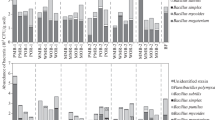Summary
Comparative studies of the rhizosphere of ericaceous plants have indicated that the viable counts of bacteria were higher in the rhizosphere than in the control soil (acid forest soil, pH 3.8). Neither physiological nor morphological dissimilarities were very distinct. The number of auxoautotrophic bacteria was lower in the rhizosphere than in the surrounding soil. In the soil pleomorphic bacteria were as common as non-pleomorphic ones, whereas in the rhizosphere, organisms belonging to the non-pleomorphic group dominated. Further studies of ten different strains (five from the rhizosphere and five from the soil) have shown that the non-pleomorphic strains belong to the genera Pseudomonas, Achromobacter, and Flavobacterium, while the pleomorphic organisms showed properties corresponding to characteristics of the soil corynebacteria. The taxonomic position of these bacteria was less clear, but the observations indicate that they belong to the genus Arthrobacter.
Similar content being viewed by others
References
Alexander, M., Introduction to soil microbiology. John Wiley & Sons, Inc., New York and London (1961).
Gyllenberg, H., The ‘rhizosphere effect’ of graminaceous plants in virgin soils. Physiol. Plantarum8, 644–652 (1955).
Gyllenberg, H., The ‘rhizosphere effect’ of graminaceous plants in virgin soils. II. Nutritional characteristics of non-sporogenus bacteria associated with the roots. Physiol. Plantarum9, 119–129 (1956).
Gyllenberg, H. and Hanioja, P., The ‘rhizosphere effect’ of graminaceous plants in virgin soils. III. Comparison with the effect of other plants. Physiol. Plantarum9, 441–445 (1956).
Lochhead, A. G., Qualitative studies of soil micro-organisms. III. Influence of plant growth on the character of the bacterial flora. Can. J. Research18, 42–53 (1940).
Lochhead, A. G. and Chase, F. E., Qualitative studies of soil microorganisms. V. Nutritional requirements of the predominate bacterial flora. Soil Sci.55, 185–195 (1943).
Lochhead, A. G. and Thexton, R. H., Qualitative studies of soil microorganisms. VII. The ‘rhizosphere effect’ in the relation to the amino acid nutrition of bacteria. Can. J. Research25, 20–26 (1947).
Manual of Microbiological Methods, ed. by the Soc. of Amer. Bacteriologists. New York (1957).
Rhodes, M. R., The cytology of Pseudomonas spp. as revealed by a silver-plating staining method. J. Gen. Microbiol.18, 639–648 (1958).
West, P. M. and Lochhead, A. G., Qualitative studies of soil microorganisms. IV. The rhizosphere in relation to the nutritive requirements of soil bacteria. Can. J. Research18, 129–135 (1940).
Author information
Authors and Affiliations
Rights and permissions
About this article
Cite this article
Lode, A. Studies on the rhizosphere bacteria of ericaceous plants. Plant Soil 23, 161–170 (1965). https://doi.org/10.1007/BF01358342
Received:
Issue Date:
DOI: https://doi.org/10.1007/BF01358342




